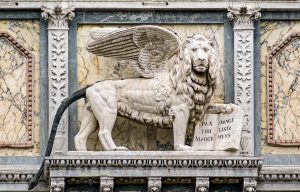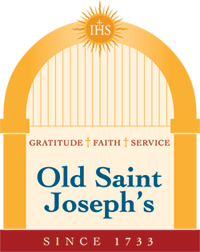Changing Gospels
by Walter F. Modrys SJ

Facade of Scuola Grande di San Marco (Venice) – Lion of San Marco
Most people don’t have a FAVORITE gospel. But if you press them, a lot of times they’ll say “John’s gospel.” But press further, and you’ll probably find they have trouble explaining their preference. I wonder if they’re just impressed by the fancy, beautifully poetic language. Granted, the Fourth Gospel is tops for that.
I know it’s silly to say, but my all-time FAVORITE is Mark’s gospel. I’d like to tell you why I say that. I think I can back it up.
Sadly, most people don’t pay much attention to the differences between the gospels. They just harmonize them all together. That’s their loss because we can learn a lot from the different perspectives of each evangelist. That’s true even of the so-called so-called synoptic gospels (Matthew, Mark and Luke). If you never noticed this firsthand, may I suggest you closely compare the way Mark and Luke recount the crucifixion scene. A lot of the details are consistent, but it’s two entirely different reports of the same event. What is each evangelist trying to tell us about the meaning Jesus’ death? It’s richly rewarding to think about that—and to pray over it.
The first gospel I studied closely was Mark’s gospel. It was part of a course taught by John Donahue, a Jesuit priest, now a world renowned scripture scholar. But back then he was a fresh Ph.D and not many people had ever heard of him. My term paper was based on his doctoral dissertation, which I praised highly, thus assuring a good grade for the course.
Why am I telling you all this now? Because this Sunday —the first Sunday of Advent and the official start of a new church year—we switch from reading Matthew’s gospel to Mark’s gospel at Sunday Mass. So my “preaching life” will change, turning attention to Mark. And I hope it will change your life a little bit, too.
Most scholars believe that Mark’s gospel was written first, before all the others, even though it’s positioned in second place in the Bible, after Matthew’s gospel. It’s a disputed point, but most scholars estimate that Mark wrote in the late 60’s AD, maybe forty years after the death and the resurrection appearances of Jesus. So by the time Mark wrote, all the major protagonists in the story were gone, and Mark himself was not an eyewitness to any of the events he writes about. So where did he get his information?
Mark, like the other evangelists, wrote his gospel in Greek. I’m no Greek scholar, but even I can tell that Mark wasn’t a great literary stylist. Modern translations clean up his language, obviously to improve upon some of Mark’s clumsy writing. For example, Mark starts almost every other sentence with “kai,” which is Greek for “and.” Amazing how he got that through his editors! So Mark was probably a working-class kind of guy, which sets him off from most of the other New Testament authors. Paul was a theological genius. Matthew was a distinguished rabbi. Luke was cultured and sophisticated—probably wealthy. John was some kind of mystic and a prominent religious figure in his community. (We can only surmise about the evangelists from their writings, since we really know nothing about them otherwise—despite all the legends.) But Mark was probably just a relatively uneducated ordinary “Joe.” That plus his natural talent gave him an extraordinarily keen eye. Mark includes down-to-earth details in his stories that others miss. Watch that as we go through the year. I love to point to such details in a homily.
Despite being a rather unsophisticated guy, Mark had a brilliant idea that hadn’t occurred to anyone before him. In Mark’s day, all the teaching and preaching about Jesus relied on little snippets—incidents from the ministry like the miracle stories or controversy stories, sayings attributed to Jesus, pieces of what the scholars call the oral tradition—all probably standing alone and disconnected. (The only possible exception was the story of the passion.) So that oral tradition was pretty much the only information that was available to Mark or to anyone else who wanted to preach about Jesus. Scholars surmise that Mark was the first one who arranged the pieces into a continuous narrative, to create a story that we call the gospel. That was Mark’s brilliant idea.
So how did Mark do the sequencing? That’s a fascinating topic. Remember, Mark was writing forty years after the events being recounted, so there was an immense backlog of pieces of traditional material. But the actual historical chronology, for the most part, had been irretrievably lost. There was no way of knowing exactly when Jesus said such-and-such or where he was when some particular miracle occurred. What guided Mark’s editorial work as an arranger—how he chose to tell the story—was his own definite religious purpose, his theology of Jesus, we would call it today. So along with his personal theology, Mark also possessed natural talent as a story teller. He knew how to state a theme early in the story and then build it up to a final dramatic climax in the trial scene and execution—almost like a modern novelist would do.
Mark chose as his unifying theme the question: Who is Jesus? From the beginning of the gospel to the very end, Mark teases the reader with that repetitive question. Indeed, some scholars refer to this literary technique as “the Messianic secret” because no one in the gospel—except the demons—can grasp and articulate who Jesus is. (By comparison, in John’s gospel, by the end of Chapter 1 Nathaniel makes a full confession of faith when he says to Jesus, “You are the Son of God.” It takes fifteen chapters before someone can say that in Mark’s gospel.)
Another way Mark demonstrates his skills as a novelist is the special way he portrays Jesus’ disciples. In Mark’s version they are far from saints. All through the story they struggle with the question, trying to identify who Jesus really is. I feel that the disciples serve as a stand-in for us, the readers, as we ourselves are challenged to deepen our encounter with the mystery of Jesus. This critical portrait of the disciples is quite different from the role the disciples play in the other gospels, and one reason why Mark’s gospel has never been much of a favorite of Church authorities through the centuries. But I’ve always felt encouraged by the way Mark captures the struggle to find the faith and the weakness we all bring to the mystery of Jesus. In this respect, Mark’s gospel is especially relevant to our own experience and the culture in which we live. Watch through the coming year how Mark’s portrait of the challenge of faith plays out in your own life of faith.
Finally, there’s another way Mark’s gospel strikingly relates to our own day. Mark’s emphasis on the suffering, crucified Jesus is a major reason why his gospel has always been such a favorite among persecuted Christians and victims of injustice. In Central and South America Mark’s gospel was adopted by the advocates of liberation theology, which was addressed to the poor and exploited population. While Dietrich Bonhoeffer, the German minister, was in prison awaiting his execution by the Nazis in the waning months of World War II, he wrote what amounts to a penetrating commentary on Mark’s gospel, entitled the Cost of Discipleship. It influenced my approach to Mark’s gospel when I read it many years ago. I hope to read it again in observance of our coming year to be spent with Mark.
We’ve been through a lot this year, some of us more than others. The world has suffered greatly. Mark wrote his gospel by inserting Jesus into a world like ours. He taught us how Jesus’ own struggles with his cross reveal how God’s saving grace has come into this very broken world. So we are in for quite a spiritual journey as we begin our reflections on Mark’s gospel.
Mass Times
Sunday at 7:30 AM, 9:30AM, 11:30 AM
Tues., Wed., & Thurs. at 12:05 PM
